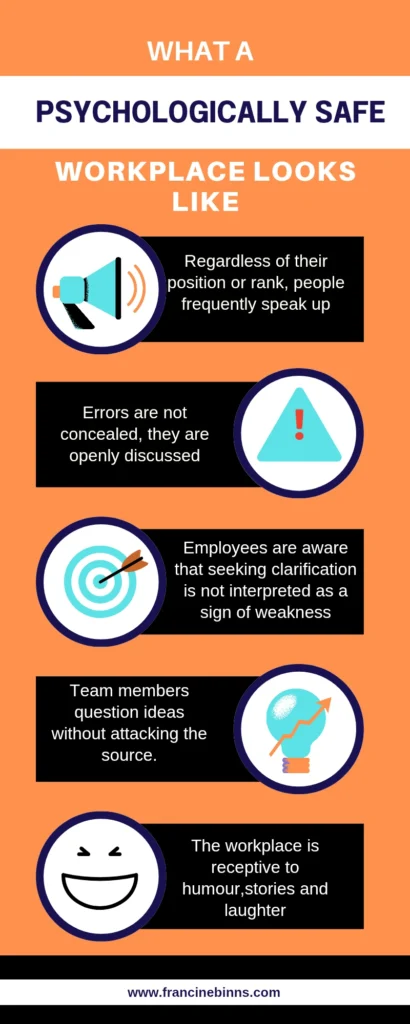I was in a team meeting when someone presented a half-formed idea, the room went quiet for a moment before a colleague jumped in to say, “That’s interesting, tell us more.” Others gave him reassuring nods. With teamwork, that original idea quickly developed into something amazing. Not only was the meeting productive, but it also demonstrated psychological safety. As someone who has seen stifled workplaces where creativity dies in silence and vibrant teams where ideas flow freely, there is a noticeable difference between the two.
The idea that team members can take risks, share ideas, and voice concerns without worrying about the repercussions is known as team psychological safety. Everyone feels free to be who they are in this setting. Amy Edmondson, a Harvard organisational behavioural scientist, was the first to recognise psychological safety as perhaps the most important component of high-performing teams. This was supported by Google’s Project Aristotle, which discovered that psychological safety was the most significant predictor of team success, surpassing even individual skill, experience, or pay.
For leaders, creating this atmosphere is about being effective, not just being kind. In this post, you will find information to help you understand if your work place is psychologically safe, how to measure team dynamics and psychological safety exercises. Businesses with safe cultures see improved business outcomes, increased engagement, and innovation. This is because errors are seen as teaching moments rather than as causes for blame, they also bounce back from setbacks faster. Here’s the difficult question, though: How can you determine if your team members are giving you what they believe you want to hear or if they feel comfortable enough to be who they are at work?
Signs of a Psychologically Safe Workplace

First, let’s look at what leaders can easily notice. You will observe several clear patterns in the interactions of employees in a psychologically safe workplace:
- Regardless of their position or rank, people frequently speak up. The junior employees are equally at ease expressing their opinions as the senior director. Everyone participates in conversations, not just the most outspoken or confident workers.
- Errors are not concealed, they are openly discussed and instead of asking “Who’s to blame?” when anything goes wrong, the focus is on “What happened and how do we fix it?” It’s also common to hear statements such as “I made a mistake on that project, and here’s what I learned.”
- Questions are welcome and frequent. Without hesitation, team members often make statements like “I don’t understand” or “Could you explain that again?” They are aware that seeking clarification is not interpreted as a sign of weakness but rather as a dedication to doing things correctly.
- Respect is shown when expressing disagreement. Team members question concepts without attacking the source. Statements like “I see it differently, and here’s why” will be heard instead of aggressive confrontation or silence.
- People bring their whole selves to work. They don’t put on a “work persona” that is quite different from who they are outside the office, they share personal stories, and they express their emotions in a healthy way.
As a leader, if you observe these behaviours in your team members on a regular basis, you are headed in the right direction. But keep in mind that the story may be more complex than what you see. People are quite good at concealing their discomfort, especially from powerful people.
Measuring your team dynamics with psychological safety assessment
You need a structured way to gauge psychological safety in order to go beyond surface observations. This is how you go about it:
- Create surveys that are anonymous and contain targeted questions. Ask specific questions like:
“How confident are you that you won’t be punished or mocked for admitting a mistake?” instead of the too general “Do you feel psychologically safe?”
“In the last month, how often did you hold back an idea because you were afraid of the response?”
“How likely are you to point out a problem, even if it might make others uncomfortable?”
- In your evaluation, look for trends rather than just averages. It’s still an issue if two members of your team consistently don’t feel comfortable, even though the majority of them do. Safety needs to be universal for it to be effective.
- When necessary, bring in outside assistance. With an impartial third party, team members may occasionally be more forthcoming. For team focus groups or interviews, think about hiring a facilitator.
- Analyse reactions over time.Developing psychological safety is a continuous process, not something you do just once. Keep an eye on how it changes, particularly during stressful times or team transitions.
Be mindful of nonverbal cues. During meetings, are people looking each other in the eye? Do they wait for their turn to speak or do they genuinely discuss each other’s ideas? You may learn a lot about people’s feelings of safety from these small clues.
Keep in mind that the purpose of this assessment is to pinpoint particular areas where you may improve, not to achieve a flawless score. If you find that team members feel comfortable sharing ideas but not owning up to their faults, it will give you a clear focus for your efforts.

Psychological Safety Exercises

Now that you understand what you are looking for in your employees, let’s discuss several exercises that can promote psychological safety in your organization:
- Begin with yourself.
Show vulnerability first as a leader by talking about your personal errors and the lessons you learned from them. Share instances where you were mistaken or had to change your mind after learning some new information. This demonstrates that others can safely follow suit.
- Try the “Just like me” exercise.
Have everyone reflect in silence at the beginning of a meeting on this: “Like me, everyone here wants to be appreciated. Like me, everyone here has fears and concerns.” This small change in perspective helps build empathy and lessens the tendency to view coworkers as “other.”
- Implement “What I know / What I don’t know” rounds into practice. Before starting a project, ask each team member to identify their areas of confidence and uncertainty. This normalizes not knowing everything and creates opportunities for mutual assistance.
- Engage in “Yes, and…” conversations. This method, which was taken from improv comedy, asks participants to expand on the ideas of others rather than criticising them right away. It promotes investigation before assessment, but it does not imply that you must agree with everything.
- Provide clear opportunities for learning from mistakes. Organise a “failure debrief” with an emphasis only on learning when anything goes wrong. Stop the use of phrases such as “you should have” and replace them with, “next time, we could…”
- Take turns facilitating meetings.
Allowing other team members to take the lead in conversations promotes power sharing and guarantees that multiple communication styles are valued.
These activities don’t need to feel awkward or forced, it will help if you naturally integrate them into your current work schedule. The secret is consistency; a single trust-building exercise won’t change your team’s culture overnight, but consistent practice will.
Challenges and Pitfalls
Creating psychological safety is not always straightforward, here are a few common problems and how leaders can address them:
1. The “urgency trap:”
When deadlines are approaching, the temptation to ignore the “soft stuff” and concentrate only on tasks will arise. However, this is the very moment when psychological safety is most important. Make it apparent that teamwork is still crucial, especially in stressful situations.
2. The explanation that "that's just how they are:"
One team member’s actions can occasionally continuously jeopardise safety; they may be quick to place blame or ignore the opinions of others. Don’t dismiss this as a personality quirk, directly address the particular behaviours and their impact.
3. The "culture clash:"
This occurs when members of a team have diverse backgrounds. Expectations regarding communication and conflict may change among people from various generations, cultures, or occupations. Establish clear team rules that recognise these distinctions and identify areas of agreement.
4. The "safety vs. accountability" false choice
Psychological safety, according to some leaders, may entail settling for mediocrity. It doesn’t, in actuality, when accountability is equitable and expectations are explicit, teams feel most secure. You may state “we hold ourselves to high standards” and “it’s okay to make mistakes” at the same time.
5. The "leader's blind spot:"
This is when you believe everything is fine because no one has told you otherwise. Keep in mind that there is an inherent power dynamic created by your position of authority. Make sure you’re creating an environment where individuals feel comfortable providing you with honest feedback on a regular basis
To overcome these obstacles, constant focus and adaptation are needed. Aim for progress rather than perfection and be prepared to change direction when necessary
Psychological safety is a basic requirement for productive teamwork, not just a nice-to-have aspect of company culture. Your employees contribute to the fullest extent possible when they feel free to express themselves, take risks, and be authentic. Innovation also flourishes, issues are resolved more quickly, and ideas are allowed to flow freely.
It is not possible to overestimate your contribution as a leader in building this atmosphere. The tone is set by your actions first, you set an example for behaviour that promotes safety when you admit your mistakes, ask for help, respect opposing viewpoints, and react positively to negative news. Want clear direction for your development? Subscribe to our newsletter and receive our assessment tool right away. It analyzes your results automatically and shows you exactly what areas need your attention.
Remember that psychological safety isn’t about avoiding difficult topics or being kind. It’s about creating an environment that allows those difficult conversations to take place in a constructive way. It’s about building a team where the goal is to improve as a group, not to defend oneself or hide shortcomings.
Take a good look at your team today. Do they bring their whole self to the workplace? Are they voicing their thoughts, queries, and worries? Are they learning from their mistakes and taking calculated risks? If not, you have work ahead of you, but the rewards in terms of results, engagement, and innovation will be worthwhile. Beyond what they’re demonstrating right now, your team has so much more to contribute. The question is, will you establish the circumstances in which they feel secure enough to show it?



